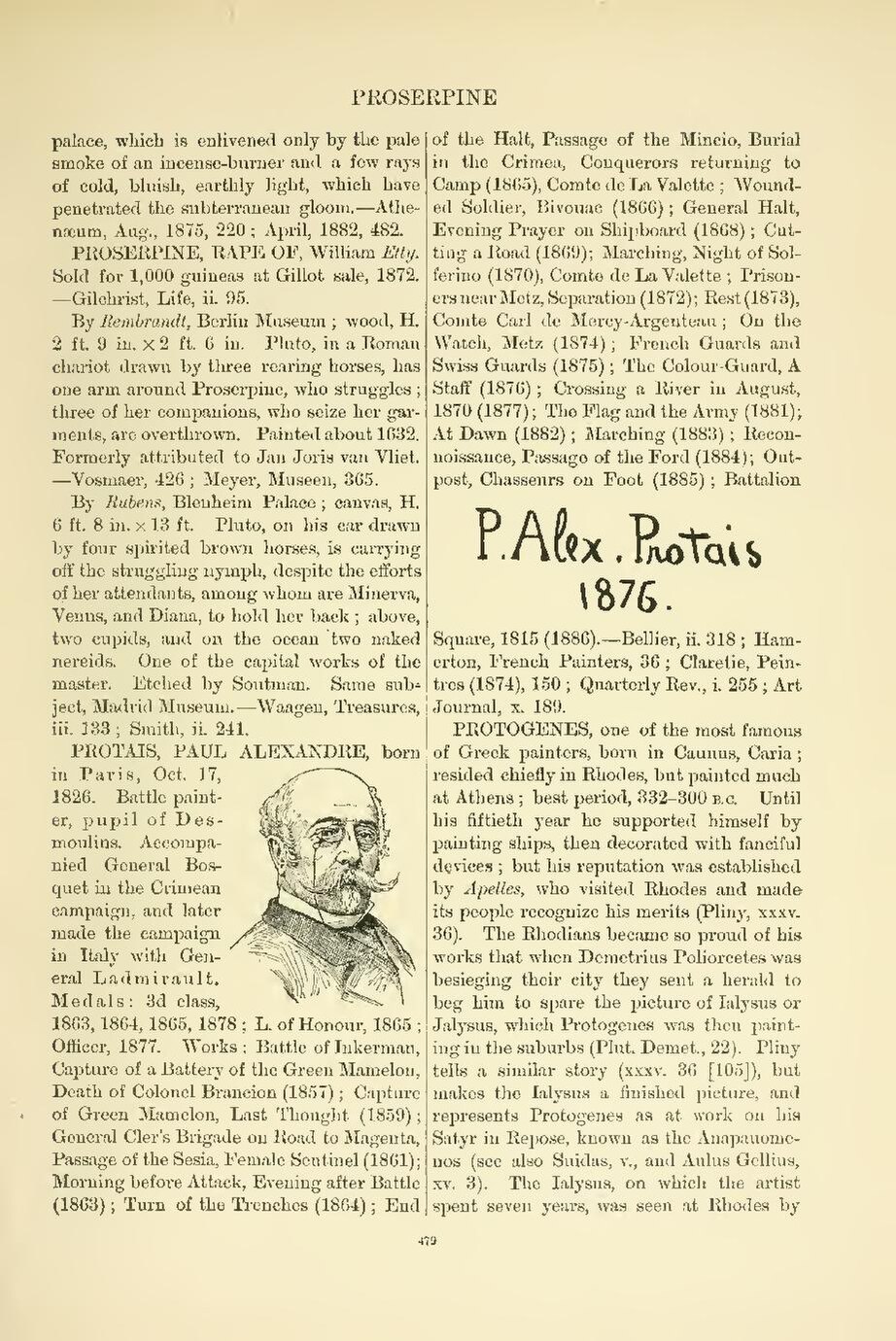palace, which is enlivened only by the pale smoke of an incense-burner and a few rays of cold, bluish, earthly light, which have penetrated the subterranean gloom.—Athenæum, Aug., 1875, 220; April, 1882, 482.
PROSERPINE, RAPE OF, William Etty.
Sold for 1,000 guineas at Gillot sale, 1872.—Gilchrist,
Life, ii. 95.
By Rembrandt, Berlin Museum; wood, H. 2 ft. 9 in. × 2 ft. 6 in. Pluto, in a Roman chariot drawn by three rearing horses, has one arm around Proserpine, who struggles; three of her companions, who seize her garments, are overthrown. Painted about 1632. Formerly attributed to Jan Joris van Vliet.—Vosmaer, 426; Meyer, Museen, 365.
By Rubens, Blenheim Palace; canvas, H. 6 ft. 8 in. × 13 ft. Pluto, on his car drawn by four spirited brown horses, is carrying off the struggling nymph, despite the efforts of her attendants, among whom are Minerva, Venus, and Diana, to hold her back; above, two cupids, and on the ocean two naked nereids. One of the capital works of the master. Etched by Soutman. Same subject, Madrid Museum.—Waagen, Treasures, iii. 133; Smith, ii. 241.
An image should appear at this position in the text. To use the entire page scan as a placeholder, edit this page and replace "{{missing image}}" with "{{raw image|Cyclopedia of painters and paintings (IA cyclopediaofpain03cham).pdf/501}}". Otherwise, if you are able to provide the image then please do so. For guidance, see Wikisource:Image guidelines and Help:Adding images. |
PROTAIS, PAUL ALEXANDRE, born
in Paris, Oct. 17,
1826. Battle painter,
pupil of Desmoulins.
Accompanied
General Bosquet
in the Crimean
campaign, and later
made the campaign
in Italy with General
Ladmirault.
Medals: 3d class,
1863, 1864, 1865, 1878; L. of Honour, 1865;
Officer, 1877. Works: Battle of Inkerman,
Capture of a Battery of the Green Mamelon,
Death of Colonel Brancion (1857); Capture
of Green Mamelon, Last Thought (1859);
General Cler's Brigade on Road to Magenta,
Passage of the Sesia, Female Sentinel (1861);
Morning before Attack, Evening after Battle
(1863); Turn of the Trenches (1864); End
of the Halt, Passage of the Mincio, Burial
in the Crimea, Conquerors returning to
Camp (1865), Comte de La Valette; Wounded
Soldier, Bivouac (1866); General Halt,
Evening Prayer on Shipboard (1868); Cutting
a Road (1869); Marching, Night of Solferino
(1870), Comte de La Valette; Prisoners
near Metz, Separation (1872); Rest (1873),
Comte Carl de Mercy-Argenteau; On the
Watch, Metz (1874); French Guards and
Swiss Guards (1875); The Colour-Guard, A
Staff (1876); Crossing a River in August,
1870 (1877); The Flag and the Army (1881);
At Dawn (1882); Marching (1883); Reconnoissance,
Passage of the Ford (1884); Outpost,
Chasseurs on Foot (1885); Battalion
Square, 1815 (1886).—Bellier, ii. 318; Hamerton,
French Painters, 36; Claretie, Peintres
(1874), 150; Quarterly Rev., i. 255; Art
Journal, x. 189.
An image should appear at this position in the text. To use the entire page scan as a placeholder, edit this page and replace "{{missing image}}" with "{{raw image|Cyclopedia of painters and paintings (IA cyclopediaofpain03cham).pdf/501}}". Otherwise, if you are able to provide the image then please do so. For guidance, see Wikisource:Image guidelines and Help:Adding images. |
PROTOGENES, one of the most famous of Greek painters, born in Caunus, Caria; resided chiefly in Rhodes, but painted much at Athens; best period, 332-300 B.C. Until his fiftieth year he supported himself by painting ships, then decorated with fanciful devices; but his reputation was established by Apelles, who visited Rhodes and made its people recognize his merits (Pliny, xxxv. 36). The Rhodians became so proud of his works that when Demetrius Poliorcetes was besieging their city they sent a herald to beg him to spare the picture of Ialysus or Jalysus, which Protogenes was then painting in the suburbs (Plut. Demet., 22). Pliny tells a similar story (xxxv. 36 [105]), but makes the Ialysus a finished picture, and represents Protogenes as at work on his Satyr in Repose, known as the Anapauomenos (see also Suidas, v., and Aulus Gellius, xv. 3). The Ialysus, on which the artist spent seven years, was seen at Rhodes by
